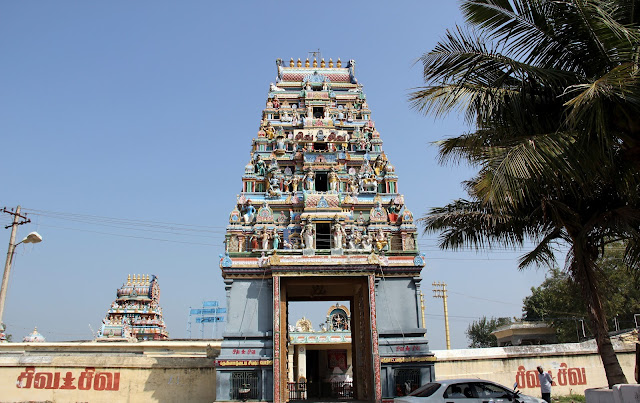Thripuranthakeswarar Temple, Thiruvirkolam, Coovum – The
Temple
The 7th century brick temple was rebuilt as the stone
temple by Nagarathars in the 11th century CE. The huge temple with the river
Cooum alongside has the south facing small tower with Ganesha and Kartikeya
idols at the tower entrance. The east facing temple has two corridors and its
main tower (Rajagopuram) has 5-tiers. The outer prakara is very huge; however,
there is no shrine or idol found here except that of Navagraha. The main shrine
is facing the east direction; a long flag post, bali peetha and Nandi idol are
located facing the main shrine.
The entrance to the main shrine is not at the front side
but on the right side facing the southern direction. Presiding Deity is called
as Tripuranthaka Swami / Thiruvirkolanathar. There is an injury scar on the
head of Lord Shiva. Hence, pujas are performed without touching the head
of the Lord. Borneol (Pachai Karpooram) is sprayed on Lord’s head and abishek
is performed with milk. This Shiva lingam is not touched by human hands, not
even by the priests, as it is “Theendathirumeni”.
The significance of this Shiva lingam is that its colour
changes to white before heavy rainfall and to red when the rain is less. This
used to serve as an indication for rainfall. Saint Thiru Gnanasambandhar in his
hymns on Lord Shiva of this temple has mentioned about the changes in colour of
this lingam. However, now the colour of the lingam does not seem to change.
Apart from this phenomenon, Saint Thiru Gnanasambandhar also talks about the
Thiripura Samharam in his hymns.
Of the temples surrounding Chennai, this is ‘Agni
Sthala’. The vimana (roof tower) of the sanctum sanctorum is designed in a
special way that is exclusive to Pallava architecture - the Gaja Brushtam, that
looks like the rear of an elephant (Gaja - elephant, Brushtam - rear). The
demons, Tharaka and Vidyunmali are the Dwarapalakas (securities) of the sanctum
sanctorum. The unique feature of this temple is that Lord Shiva’s
procession idol (Utsavar) can be seen holding a bow and arrow in his hands.
Such an idol is very rare and cannot be seen anywhere else.
Flowers and a small stick are brought from the Nandavanam at Pinjivakkam. Only these flowers will used for adorning the Lord. Water
for doing rituals of the Avudaiyar is brought from a Abshika Kuzhi, few Kms away from the Temple. It is believed that if water from any other
source is used for abishekam, one can see a lot of ants on the lingam.
The wall
surrounding the sanctum sanctorum has the Goshtam idols of Ganesha,
Dakshinamurthy, Annamalaiyar, Brahma, Durga and Chandikeswarar. All these
bas-relief images are very attractive. The Ardha Mandapa in the main
shrine of Shiva has few idols such as Surya, Nalvar, etc. and very beautiful
Utsava (bronze) idols.
Mother is called as Tripuranthaka Nayagi / Thiripurasundari.
Mother’s shrine is right of that of Lord facing east in a standing form. Goddess
is very tall with four arms. The shrine has a front side mandapa and there is a
separate flag post and Simha (lion) idol facing the shrine. Sri Chakra is
installed in the shrine. Devotees believe that worshipping Mother would
break the obstacles in the way of wedding proposals. The Vimana of the
sanctum of Mother is in the form of a tower. A unique
custom followed in this temple is that devotees are to worship Goddess
Thiripurasundari before worshipping Lord Tripuranthaka.
Shrines and idols of Lords Achirutha Vinayakar,
Natarajar, Murugan with his consorts, Dakshinamurthy, Brihadeeswarar, Lingothbavar,
Meenakshi-Sundareswarar, Bala Murugan, Durgai, Chandikeswarar, Bairavar and
Navagrahams can be seen in the corridors. Outside this temple, there is a
separate shrine for Lord Mahavishnu. The shrine where Lord Nataraja played the Raksha
Thandavam (protection dance) is in the Mahamandapam opposite the Rajagopuram
main tower. Kali was once defeated by Nataraja (Shiva) in dance competition. In
this site, Nataraja danced with pleasure to please Kali; hence, the dance form
in this shrine is called as 'Raksha Natanam'.
The temple tank is called
Achirutha Keni. There are
no frogs or fish ever in this temple tank. Kali is
gracing the devotees in the name of Tharka Madha in a separate shrine a little
away from the temple. Kali assumed the name of Tharka Madha as she
contested against Lord Shiva in the dance competition. Tharka in Sanskrit means
debate.
Lord Muruga with his six faces and with his consorts
Valli and Deivanai is in a separate shrine. Bhairava is found
unusually without his vaahana dog in a sub shrine in the inner prakara. It is
said that when Shiva was getting ready to wage war against the demons, he went
to invite all the Devas; during that time, his dog lost its path. Hence, he is
found without vaahana in this temple. Sthala Vriksham is Vilwa Tree. Theerthams
associated with this temple are Agni Theertham and Achirutha Theertham.
When Shiva lost the axle of his chariot, Lord Vishnu helped him. He is found in the name of Kariya Manicka Perumal with his consorts - Sree Devi and Bhoo Devi, in a separate small temple. This temple is very small and found outside the main temple. It also appears to be an ancient temple. Apart from the main deity, Hanuman idol is also found in this small temple. Another interesting feature of the temple is Buddhist Dharmachakra (possibly) is found near the entrance of the temple. It is said that a big idol of Buddha was unearthed in this site few years ago. There is a “Rudraksha” tree near this temple.













































































